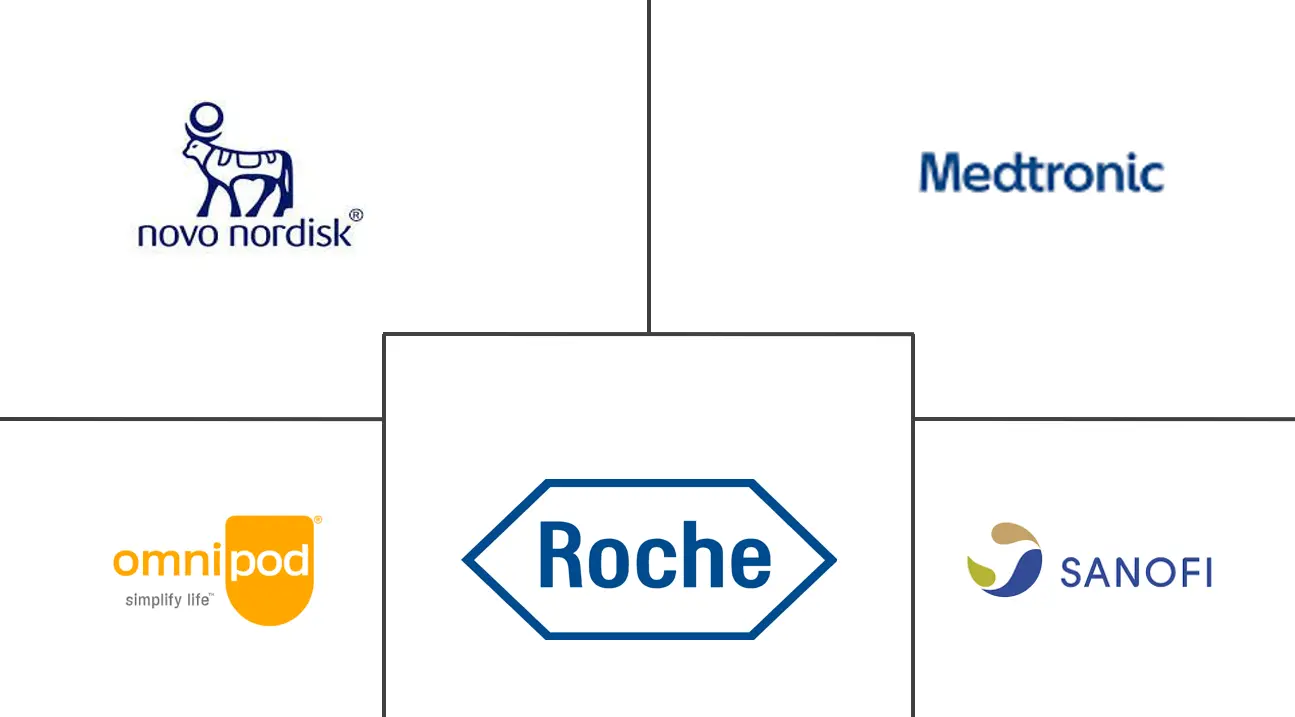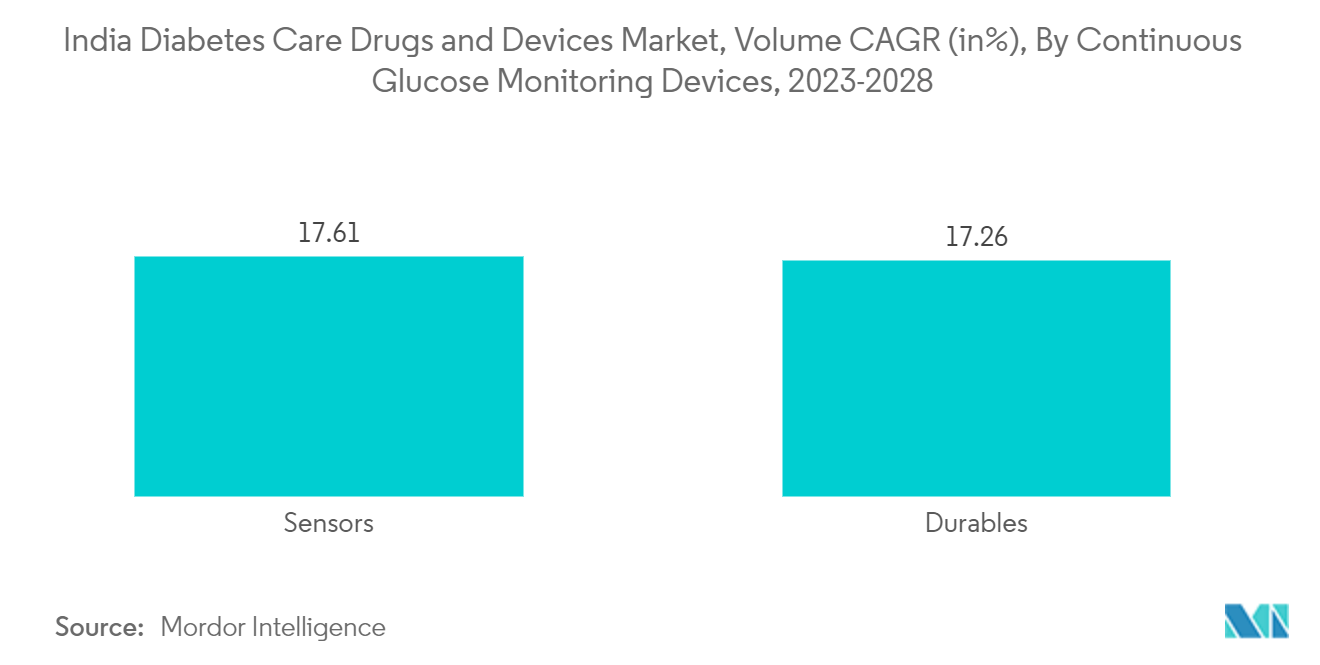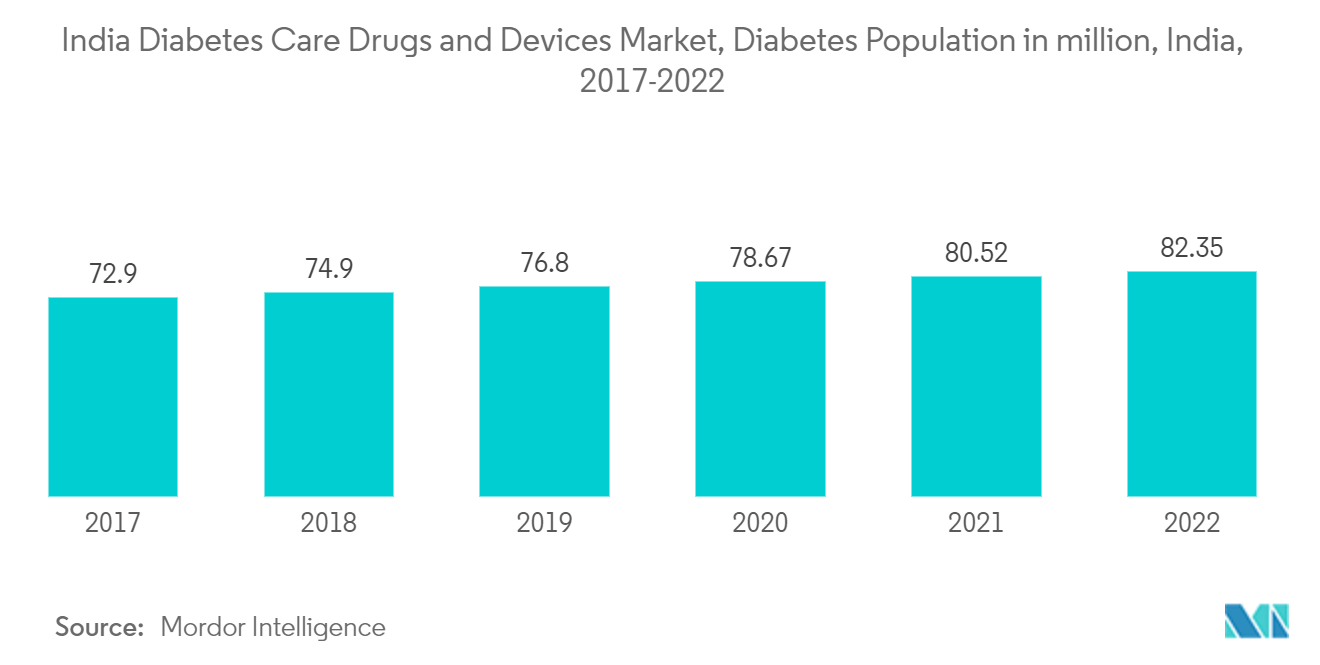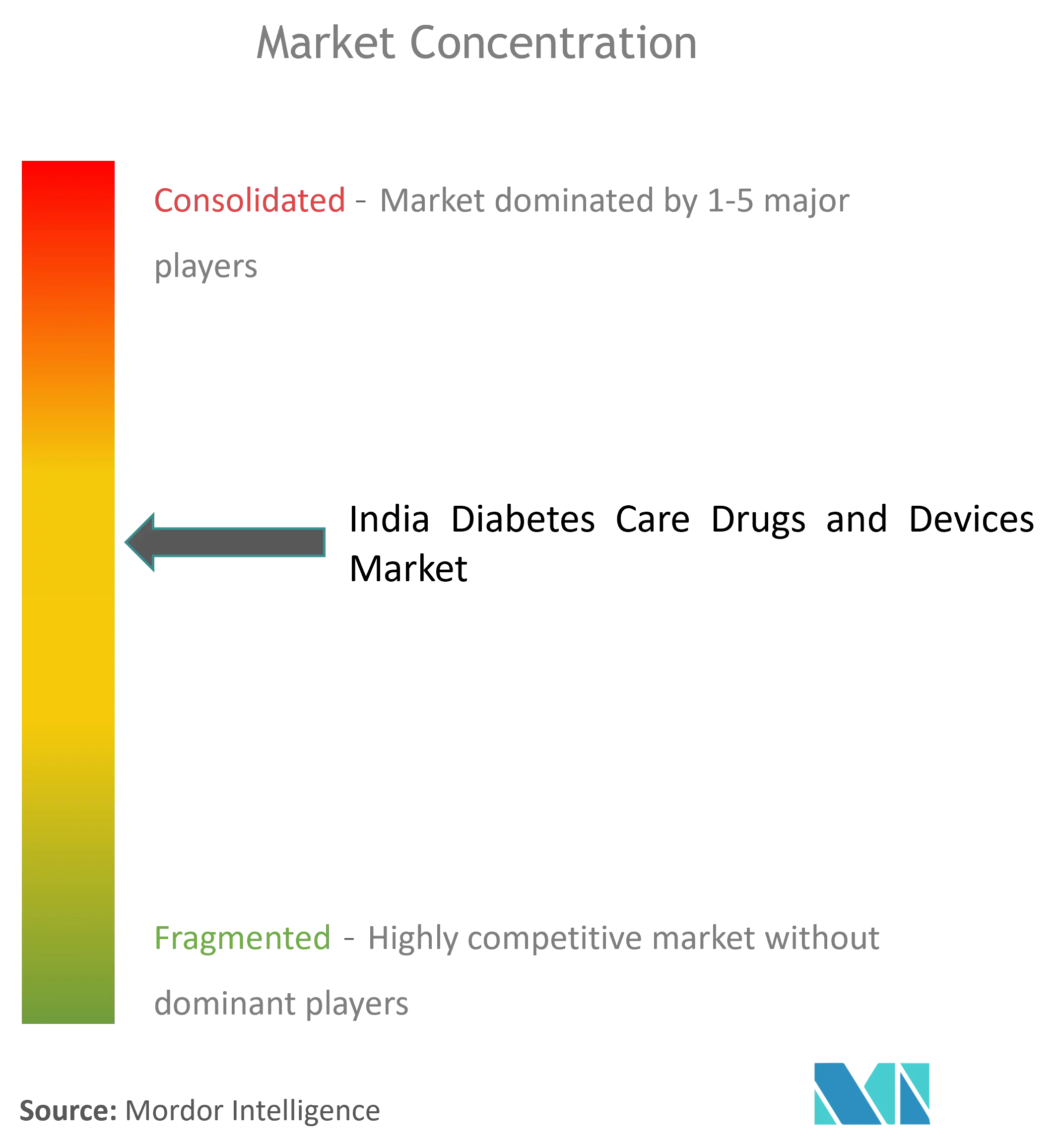India Diabetes Drugs and Devices Market Size

| Study Period | 2018 - 2029 |
| Base Year For Estimation | 2023 |
| Forecast Data Period | 2024 - 2029 |
| Historical Data Period | 2018 - 2022 |
| CAGR | > 3.00 % |
Major Players
*Disclaimer: Major Players sorted in no particular order |
India Diabetes Drugs and Devices Market Analysis
India's diabetes care drugs and devices market size is estimated at USD 3.8 billion in the current year. The market is expected to reach USD 4.4 billion in five years, registering a CAGR of more than 3% during the forecast period.
In India, the COVID-19 outbreak began nearly two years ago and has increased by nearly 25%. With over 80 million diabetics, India is called the Diabetes Capital. COVID-19 is a viral infection that causes various inflammatory responses and is associated with several recurring and emerging health problems, including hypoxia, wasting, weight loss, hair loss, myocarditis, and thyroid problems. Increase. However, diabetes is one of the most common side effects of infections. Anoop Misra, a senior endocrinologist in Delhi, observed the prevalence of new-onset diabetes and thyroid dysfunction in patients with COVID-19 in all countries; He said the explanations included the severe effects of a cytokine surge (the strong immune responses reported in certain COVID-19 patients) and some development of autoimmunity (the body's immune system goes awry and when it affects the tissues and organs of the body), it was speculated that it might be included.
A review of literature from around the world finds that metformin is used in various ways in the early stages of diabetes. Sharma et al. found a changing trend in 55% of metformin-treated individuals. The fraction of individuals on metformin remains stable from 0 to 20 years of diabetes. The proportion of sulfonylurea and dipeptidyl peptidase-4 inhibitors (DPP4i) increases from 23.12% and 22.5% in 0-5 years of diabetes to 70.77% and 60% in 10-15 years of diabetes. Following that, the proportion of sulfonylurea and DPP4i remains constant. As the use of sulfonylureas and DPP4i reaches a plateau, insulin and sodium/glucose cotransporter two inhibitors increase. From 5 to 10 years of diabetes duration to 20+ years of diabetes duration, the proportion of alpha-glucosidase inhibitors increases somewhat. Thiazolidinediones and glucagon-like peptide-1 receptor agonists have a small proportion in contemporary practice and the given patient population.
Thus, the above factors are expected to drive the market growth over the forecast period.
India Diabetes Drugs and Devices Market Trends
The continuous Glucose Monitoring Segment is Expected to Witness the Highest Growth Rate Over the Forecast Period
The continuous blood glucose monitoring segment is projected to grow at a CAGR of around 11.93% during the forecast period.
According to estimates for 2022, people living in Indian cities and metropolitan areas will be more likely than ever to develop diabetes. This is partly because cities encourage lifestyles that can increase a person's total body mass index (BMI). A high BMI is a risk factor for diabetes. Type 2 diabetes is also on the rise in rural India. Diabetes is considered a new disease in rural areas and public understanding of the disease is poor.
This sensor device is a small electrode that measures the blood sugar level of diabetics. The sensor continuously measures glucose levels in the body through small threads inserted under the skin and records glucose levels. Within 5 seconds, the user can download the data stored in the sensor. The Indian continuous blood glucose monitoring device market considers the FreeStyle Libre Pro sensor (14-day run), Dexcom's G4 sensor (10-day run), Medtronic's Guardian sensor (7-day run), and fluorescence sensors. Dexcom continues to market the Dexcom G4 Platinum CGM system in India, while Dexcom G5 and G6 CGM technology are marketed in other countries. Dexcom planned to introduce a low-cost, small-size sensor developed in collaboration with the Verily Life Sciences division. The introduction of his low-cost CGM in the next few years and government support through subsidies for diabetes monitoring devices could allow the CGM device maker to enter the promising Indian market.

Rising diabetes prevalence
There are currently 82 million people suffering from diabetes in India and by 2027, almost 10% of the Indian population is expected to have diabetes. Obesity, especially central obesity, increased visceral fat due to lack of exercise, and intake of a diet high in calories, fat, and sugar are the main causes of diabetes in Indians. The most pervasive work culture in the country, which involves sitting in the same position for hours on end and eating fast food with little or no physical activity, is a major cause of the emergence of diabetes in the working-age population. This has led to a rapid increase in such diabetes. Diabetes cases in India.
In March 2022, the Indian Council of Medical Research-National Centre for Disease Informatics (ICMR-NCDIR), Bengaluru researchers said that THE PREVALENCE of diabetes and impaired fasting glucose is high among adults while the levels of awareness, treatment, and control are still low in India. According to AIIMS, the risk of fatal outcomes from COVID-19 is up to 50% higher in people with diabetes, than in those who do not have diabetes in India. Diabetes and high glucose levels are associated with increased complications, respiratory failure, and mortality in hospitalized patients with COVID-19.
According to an article published in THE HINDU, one in six people with diabetes in the world is Indian. According to this figure, the country is among the top 10 countries with the most diabetes and ranks second with an estimated 80 million people with diabetes. More than half of India's population is at risk of developing diabetes at some point in their lives, making the disease a major public health concern. He also observed an increase in the incidence of type 2 diabetes in rural areas of India. Diabetes is a disease with no cure. In our current arsenal, it is a disease that affects the patient for the rest of their lives. Between the ages of 30 and 90, people are exposed to significant economic, social, and psychological stress. According to all current guidelines in India, metformin should be the first-line oral antidiabetic drug at the onset of diabetes. The increasing diabetes prevalence and the above factors will likely drive segment growth over the forecast period.

India Diabetes Drugs and Devices Industry Overview
Manufacturers have always innovated to outlive in the industry. Big firms as an example Abbott and Medtronic have made abundant mergers, acquisitions, and partnerships to attain industry dominance whereas adhering to biological development techniques. The manufacturers of insulin delivery tools are spending substantial amounts on the R&D of the tools. For example, Novo Nordisk partnered with Abbott Diabetes Care, that may additionally aid to enable insulin statistics to be shared between Novo Nordisk-connected insulin pens and digital fitness trappings well qualified to the FreeStyle Libre portfolio of cosmetics.
India Diabetes Drugs and Devices Market Leaders
-
Medtronics
-
Roche
-
NovoNordisk
-
Sanofi
-
Omnipod
*Disclaimer: Major Players sorted in no particular order

India Diabetes Drugs and Devices Market News
- November 2022: AstraZeneca India gets approval to market the anti-diabetes drug Dapagliflozin. The company said it had received approval from the Central Drugs Standard Control Organization (CDCSCO) for the drug indicated for diabetes patients with chronic kidney disease (CKD).
- March 2022: Medtronic India launched the MiniMed 780G, a next-generation closed-loop insulin pump system. The MiniMed 780G system is a next-generation closed-loop insulin pump system for treating type-1 diabetes in people aged 7-80 years.
Table of Contents
1. INTRODUCTION
1.1 Study Assumptions and Market Definition
1.2 Scope of the Study
2. RESEARCH METHODOLOGY
3. EXECUTIVE SUMMARY
4. MARKET DYNAMICS
4.1 Market Overview
4.2 Market Dynamics
4.2.1 Market Drivers
4.2.2 Market Restraints
4.3 Porter's Five Forces Analysis
4.3.1 Bargaining Power of Suppliers
4.3.2 Bargaining Power of Consumers
4.3.3 Threat of New Entrants
4.3.4 Threat of Substitute Products and Services
4.3.5 Intensity of Competitive Rivalry
5. Market Segmentation (Market Size by Value - USD)
5.1 Devices
5.1.1 Monitoring Devices
5.1.1.1 Self-monitoring Blood Glucose Devices
5.1.1.2 Continuous Blood Glucose Monitoring
5.1.2 Management Devices
5.1.2.1 Insulin Pump
5.1.2.2 Insulin Syringes
5.1.2.3 Insulin Cartridges
5.1.2.4 Disposable Pens
5.2 Drugs
5.2.1 Oral Anti-Diabetes Drugs
5.2.2 Insulin Drugs
5.2.3 Combination Drugs
5.2.4 Non-Insulin Injectable Drugs
6. Market Indicators
6.1 Type-1 Diabetes Population
6.2 Type-2 Diabetes Population
7. COMPETITIVE LANDSCAPE
7.1 Company Profiles
7.1.1 Novo Nordisk
7.1.2 Medtronic
7.1.3 Insulet
7.1.4 Tandem
7.1.5 Ypsomed
7.1.6 Novartis
7.1.7 Sanofi
7.1.8 Eli Lilly
7.1.9 Abbottt
7.1.10 Roche
7.1.11 Astrazeneca
7.1.12 Dexcom
7.1.13 Pfizer
- *List Not Exhaustive
7.2 Company Share Analysis
8. MARKET OPPORTUNITIES AND FUTURE TRENDS
India Diabetes Drugs and Devices Industry Segmentation
Patients with type 1 diabetes must be given insulin because their pancreas cannot process it. To control blood sugar levels, insulin must be given several times a day, such as when eating or drinking. Many people with type 2 diabetes also need to take antidiabetic drugs. These drugs include diabetes medications and injections, such as insulin. The India diabetes drugs and devices market is segmented by drugs (insulin, oral anti-diabetic drugs, non-insulin injectable drugs, and combination drugs), and devices (management devices such as insulin pumps, insulin pens, syringes, cartridges, and jet injectors, and monitoring devices including self-monitoring blood and continuous glucose monitoring). The report offers the value (in USD) and volume (in unit) for the above segments.
| Devices | ||||||
| ||||||
|
| Drugs | |
| Oral Anti-Diabetes Drugs | |
| Insulin Drugs | |
| Combination Drugs | |
| Non-Insulin Injectable Drugs |
Frequently Asked Questions
What is the current India Diabetes Drugs and Devices Market size?
The India Diabetes Drugs and Devices Market is projected to register a CAGR of greater than 3% during the forecast period (2024-2029)
Who are the key players in India Diabetes Drugs and Devices Market?
Medtronics , Roche, NovoNordisk, Sanofi and Omnipod are the major companies operating in the India Diabetes Drugs and Devices Market.
What years does this India Diabetes Drugs and Devices Market cover?
The report covers the India Diabetes Drugs and Devices Market historical market size for years: 2018, 2019, 2020, 2021, 2022 and 2023. The report also forecasts the India Diabetes Drugs and Devices Market size for years: 2024, 2025, 2026, 2027, 2028 and 2029.
India Diabetes Drugs and Devices Industry Report
Statistics for the 2024 India Diabetes Drugs and Devices market share, size and revenue growth rate, created by Mordor Intelligence™ Industry Reports. India Diabetes Drugs and Devices analysis includes a market forecast outlook to for 2024 to 2029 and historical overview. Get a sample of this industry analysis as a free report PDF download.



